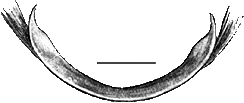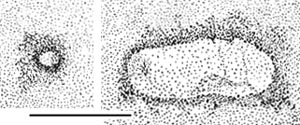- Eyes
- "...rather small and inconspicuous."
- Funnel
- Slender; funnel organ a pair of small, oval pads.
- Fins
- "...minute, tenuous... ."
- Gills
- Six primary lamellae on one side and 6 plus one poorly developed additional lamella on other side.
- Six primary lamellae on one side and 6 plus one poorly developed additional lamella on other side.
- Optic lobes and nerves
- Unknown
- Unknown
- Digestive system
- Digestive gland bilobed (O'Shea, 1999).
- Digestive gland bilobed (O'Shea, 1999).
- Beaks
- Upper beak with a "distinct angle along each outer side of the beak at the shoulder.".
- Shell
- Shell with broad U-shape.
- Saddle with a posterior groove.
- Pigmentation
- Aboral surfaces nearly colorless or with a light dirty gray but with traces of a superficial membrane lightly pigmented with streaks of brown.
- Oral surfaces superficial integument colorless and transparent. Deeper layer dark bluish slate but paler along the arms and over a ring-like zone a little distance from mouth.
- Suckers and cirri light yellowish brown.
- Areolae present: each with small, clear central area. Overall, areolae very small.
- Measurements and counts
These measurements and counts are from Berry, 1918.Sex ? Holotype ? ? Spread (arm tip to arm tip), mm 330 225 170 Fin span 75 - - Fin length 20 15 15 Fin width 14 7 6 head width 50 40 35 Arm I, length (right/left) 165/150 110/110 80/80 Arm II, length 160/160 115/115 85/85 Arm III, length 175/170 125/120 90/75+ Arm IV, length 165/165 125/110 90/90 Diam. sucker no. 5, arm I 2+ 2 1.1 Depth web sector A 100 80 60 Depth web sector C 105 85 60 Depth web sector E 115 85 60
Comments
The above description is taken from Berry (1918) except where otherwise noted.









 Go to quick links
Go to quick search
Go to navigation for this section of the ToL site
Go to detailed links for the ToL site
Go to quick links
Go to quick search
Go to navigation for this section of the ToL site
Go to detailed links for the ToL site